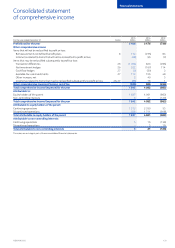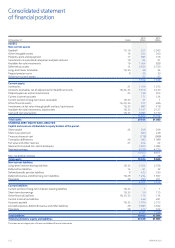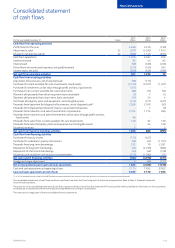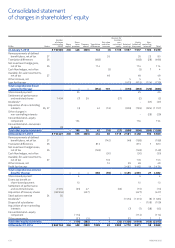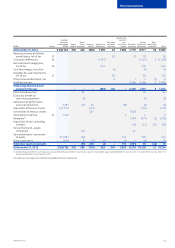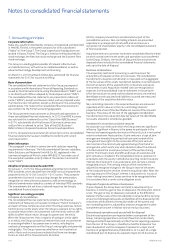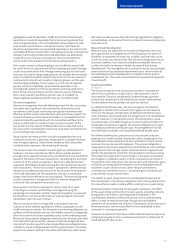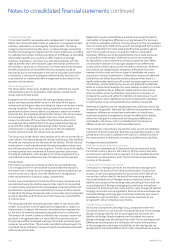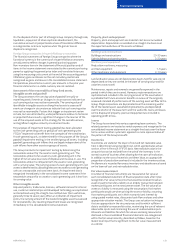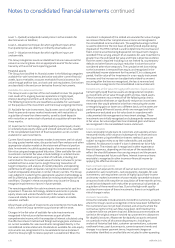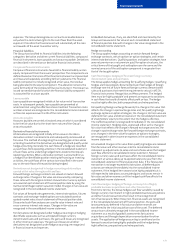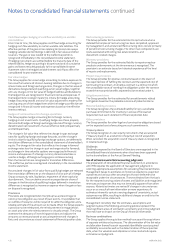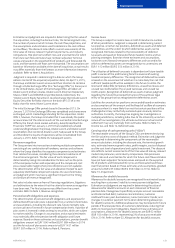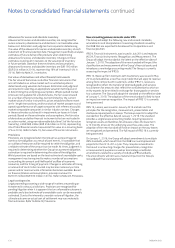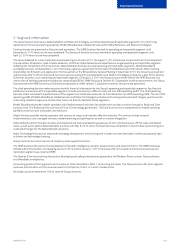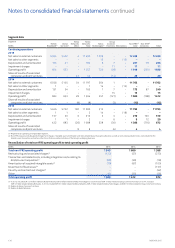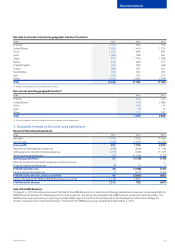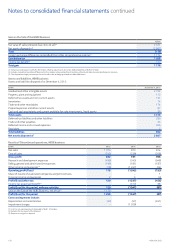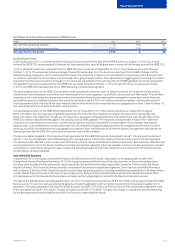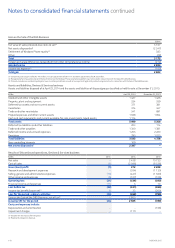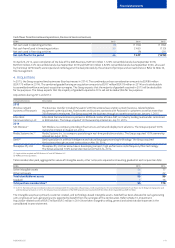Nokia 2015 Annual Report Download - page 133
Download and view the complete annual report
Please find page 133 of the 2015 Nokia annual report below. You can navigate through the pages in the report by either clicking on the pages listed below, or by using the keyword search tool below to find specific information within the annual report.
131
Financial statements
NOKIA IN 2015
expenses. The Group derecognizes an accounts receivable balance
only when the contractual rights to the cash ows from the asset
expire or it transfers the nancial asset and substantially all the risks
and rewards of the asset to another entity.
Financial liabilities
The Group has classied its nancial liabilities into the following
categories: derivative and other current nancial liabilities, compound
nancial instruments, loans payable, and accounts payable. Derivatives
are described in the section on derivative nancial instruments.
Compound nancial instruments
Compound nancial instruments have both a nancial liability and an
equity component from the issuers’ perspective. The components are
dened based on the terms of the nancial instrument and presented
and measured separately according to their substance. The nancial
liability component is initially recognized at fair value, the residual
being allocated to the equity component. The allocation remains the
same for the life of the compound nancial instrument. The Group has
issued convertible bonds for which the nancial liability component
isaccounted for as a loan payable.
Loans payable
Loans payable are recognized initially at fair value net of transaction
costs. In subsequent periods, loans payable are presented at
amortized cost using the eective interest method. Transaction costs
and loan interest are recognized in the consolidated income statement
as nancial expenses over the life of the instrument.
Accounts payable
Accounts payable are carried at invoiced amount which is considered
to be the fair value due to the short-term nature of the Group’s
accounts payable.
Derivative nancial instruments
All derivatives are recognized initially at fair value on the date a
derivative contract is entered into and subsequently remeasured at
fair value. The method of recognizing the resulting gain or loss varies
according to whether the derivatives are designated and qualify under
hedge accounting. Generally, the cash ows of a hedge are classied
as cash ows from operating activities in the consolidated statement
of cash ows as the underlying hedged items relate to the Group’s
operating activities. When a derivative contract is accounted for as
ahedge of an identiable position relating to nancing or investing
activities, the cash ows of the contract are classied in the same
wayas the cash ows of the position being hedged.
Derivatives not designated in hedge accounting relationships
carried at fair value through prot and loss
Forward foreign exchange contracts are valued at market-forward
exchange rates. Changes in fair value are measured by comparing
these rates with the original contract-forward rate. Currency options
are valued at each statement of nancial position date by using the
Garman & Kohlhagen option valuation model. Changes in fair value are
recognized in the consolidated income statement.
Fair values of forward rate agreements, interest rate options, futures
contracts and exchange-traded options are calculated based on
quoted market rates at each statement of nancial position date.
Discounted cash ow analyses are used to value interest rate and
cross-currency interest rate swaps. Changes in fair value are
recognized in the consolidated income statement.
For derivatives not designated under hedge accounting but hedging
identiable exposures such as anticipated foreign currency
denominated sales and purchases, the gains and losses are recognized
in other income or expenses. The gains and losses on all other
derivatives not designated under hedge accounting are recognized
innancial income and expenses.
Embedded derivatives, if any, are identied and monitored by the
Group and measured at fair value at each consolidated statement
ofnancial position date with changes in fair value recognized in the
consolidated income statement.
Hedge accounting
The Group applies hedge accounting on certain forward foreign
exchange contracts, certain options or option strategies, and certain
interest rate derivatives. Qualifying options and option strategies have
zero net premium or a net premium paid. For option structures, the
critical terms of the bought and sold options are the same and the
nominal amount of the sold option component is no greater than
thatof the bought option.
Cash ow hedges: hedging of forecast foreign currency
denominated sales and purchases
The Group applies hedge accounting for ‘qualifying hedges’. Qualifying
hedges are those properly documented cash ow hedges of foreign
exchange rate risk of future forecast foreign currency denominated
sales and purchases that meet the requirements set out in IAS 39,
Financial Instruments: Recognition and Measurement. The hedged
item must be ‘highly probable’ and present an exposure to variations
in cash ows that could ultimately aect prot or loss. The hedge
mustbe highly eective, both prospectively and retrospectively.
For qualifying foreign exchange forwards, the change in fair value that
reects the change in spot exchange rates and, for qualifying foreign
exchange options or option strategies, the change in intrinsic value are
deferred in fair value and other reserves in the consolidated statement
of shareholders’ equity to the extent that the hedge is eective.
Theineective portion is recognized immediately in the consolidated
income statement. Hedging costs, expressed either as the change in
fair value that reects the change in forward exchange rates less the
change in spot exchange rates for forward foreign exchange contracts,
or as changes in the time value for options or options strategies,
arerecognized in other income or expenses in the consolidated
income statement.
Accumulated changes in fair value from qualifying hedges are released
from fair value and other reserves into the consolidated income
statement as adjustments to sales and cost of sales when the hedged
cash ow aects the consolidated income statement. Forecast
foreigncurrency sales and purchases aect the consolidated income
statement at various dates up to approximately one year from the
consolidated statement of nancial position date. If the forecasted
transaction is no longer expected to take place, all deferred gains
orlosses are released immediately into the consolidated income
statement. If the hedged item ceases to be highly probable but is
stillexpected to take place, accumulated gains and losses remain in
fairvalue and other reserves until the hedged cash ow aects the
consolidated income statement.
Cash ow hedges: hedging of foreign currency risk of highly
probable business acquisitions and other transactions
From time to time, the Group hedges cash ow variability caused by
foreign currency risk inherent in highly probable business acquisitions
and other future transactions that result in the recognition of
non-nancial assets. When those non-nancial assets are recognized
in the consolidated statement of nancial position, the gains and
losses previously deferred in fair value and other reserves are
transferred to the initial acquisition cost of the asset. The deferred
amounts are ultimately recognized in the consolidated income
statement as a result of goodwill assessments for business
acquisitions and through depreciation or amortization for other
assets. The application of hedge accounting is conditional on the
forecast transaction being highly probable and the hedge being
highlyeective, prospectively and retrospectively.


